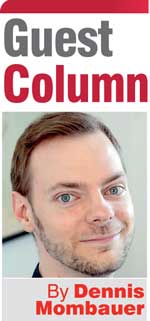Tuesday Apr 22, 2025
Tuesday Apr 22, 2025
Saturday, 10 July 2021 00:00 - - {{hitsCtrl.values.hits}}

 In today’s world, climate risk and risk management should be key elements of any planning process. Countries, companies, and individuals find themselves increasingly faced with uncertainties that threaten their operations, income, health, and even lives. Going ahead into the future, it will be essential to manage these risks in a systematic way to mitigate losses and damages, recover from shocks, and adapt to a changing environment.
In today’s world, climate risk and risk management should be key elements of any planning process. Countries, companies, and individuals find themselves increasingly faced with uncertainties that threaten their operations, income, health, and even lives. Going ahead into the future, it will be essential to manage these risks in a systematic way to mitigate losses and damages, recover from shocks, and adapt to a changing environment.
What exactly is risk? Simply put, it is the possibility of adverse impacts on something of value. The concept of “risk” encompasses different elements, including a hazard, exposure to said hazard, and vulnerabilities or sensitivities of those who are exposed. For example, a river flood after heavy rainfall is a hazard, not a risk; but if the river is lined with settlements that do not have flood-control infrastructure, the hazard turns into a risk.
The main elements of risk are interconnected and directly influence each other. Reducing exposure and vulnerability or strengthening adaptive capacities can reduce risks, enabling people to rebound from shocks and act as safety nets to prevent catastrophic losses. On the other hand, heightened vulnerability, for example due to poverty, will also increase overall risks.
Climate risk in the agriculture sector
Climate risk is a kind of risk that stems from the impacts of climate change and climate-related hazards. This includes extreme weather events such as floods, storms, or droughts, but also long-term processes such as temperature increase, sea level rise, salinity intrusion, or ecosystem degradation. However, it is rarely possible to address climate risk on its own, as it is part of a complex web of factors and characteristics.
In the agriculture sector, for example, climate risk interacts with other kinds of risk including market risks, production risks, financial risks, environmental risks, social risks, and risks related to the regulatory environment, labour force, or infrastructure. Similarly, other sectors such as fisheries, forestry, human settlements, tourism, waste management, or industry are faced with a range of risks that can enhance or compound each other and exacerbate underlying vulnerabilities.
In Sri Lanka’s agriculture sector, climate risks to smallholder farmers in Sri Lanka are mitigated through adoption of climate-smart agriculture techniques, restoration and maintenance of tank systems, a public crop insurance scheme, and other interventions in line with national policies and climate-related plans and commitments.
Managing climate risk
In general, what can be done to address climate risk? A comprehensive risk management framework works across all levels—from local to national—to reduce the overall risk and strengthen capacities to withstand risk events.
The first step is assessing risks, quantifying them, and building awareness of their likelihood and severity. Once risks are understood, they can be prevented, mitigated, or reduced through a range of interventions, for example by building better infrastructure or establishing forecast and early warning systems.
Reducing risk is possible only to an extent: in most cases, it is not viable or cost-effective to bring it down to zero. The remaining risk can be shared or transferred, for example through insurance mechanisms, by creating village risk pools, or through informal mechanisms such as borrowing money. Beyond that, residual risk can be proactively addressed by organisations and individuals, for example by allocating contingency funds or budget reserves to be used in times of need.
In today’s world, climate risk is a reality that cannot be ignored. Any continuity plan, any business activity, any enterprise or development intervention should take it into account and incorporate risk management measures, either through risk prevention, risk reduction, risk transfer, or risk retention. A comprehensive risk management framework can support livelihoods, economies, entrepreneurs, or farming households, help with climate change adaptation, and provide the safety to take chances and calculated risks.
(The writer works as Director – Research & Knowledge Management at SLYCAN Trust, a non-profit think tank based in Sri Lanka. His work focuses on climate change, adaptation, just transition, human mobility, and a range of related issues. He holds a Master’s degree in Education from the University of Cologne, Germany and is a regular writer to several international and local media outlets.)
Discover Kapruka, the leading online shopping platform in Sri Lanka, where you can conveniently send Gifts and Flowers to your loved ones for any event including Valentine ’s Day. Explore a wide range of popular Shopping Categories on Kapruka, including Toys, Groceries, Electronics, Birthday Cakes, Fruits, Chocolates, Flower Bouquets, Clothing, Watches, Lingerie, Gift Sets and Jewellery. Also if you’re interested in selling with Kapruka, Partner Central by Kapruka is the best solution to start with. Moreover, through Kapruka Global Shop, you can also enjoy the convenience of purchasing products from renowned platforms like Amazon and eBay and have them delivered to Sri Lanka.
Discover Kapruka, the leading online shopping platform in Sri Lanka, where you can conveniently send Gifts and Flowers to your loved ones for any event including Valentine ’s Day. Explore a wide range of popular Shopping Categories on Kapruka, including Toys, Groceries, Electronics, Birthday Cakes, Fruits, Chocolates, Flower Bouquets, Clothing, Watches, Lingerie, Gift Sets and Jewellery. Also if you’re interested in selling with Kapruka, Partner Central by Kapruka is the best solution to start with. Moreover, through Kapruka Global Shop, you can also enjoy the convenience of purchasing products from renowned platforms like Amazon and eBay and have them delivered to Sri Lanka.